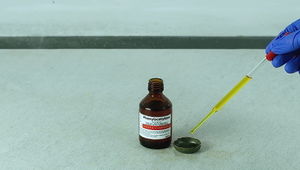Phenylacetylene
 Old phenylacetylene in a glass pipette
| |
| Names | |
|---|---|
| IUPAC name
Ethynylbenzene
| |
| Other names
1-Phenylethyne
Phenylacetylide Phenylethyne | |
| Properties | |
| C8H6 | |
| Molar mass | 102.133 g/mol |
| Appearance | Colorless or yellow liquid |
| Density | 0.9281 g/cm3 (25 °C) |
| Melting point | −44.8 °C (−48.6 °F; 228.3 K) |
| Boiling point | 143 °C (289 °F; 416 K) |
| Insoluble | |
| Solubility | Miscible with acetone, alcohols, benzene, chloroform, ethers, pyridine, toluene |
| Vapor pressure | 17.6 mm Hg (37.7 °C) |
| Acidity (pKa) | 23.2 (aq, extrapolated)[1] 28.7 (DMSO)[2] |
| Hazards | |
| Safety data sheet | Sigma-Aldrich |
| Flash point | 27 °C (80.6 °F; 300 K) |
| Related compounds | |
| Related compounds
|
Acetylene |
| Except where otherwise noted, data are given for materials in their standard state (at 25 °C [77 °F], 100 kPa). | |
| Infobox references | |
Phenylacetylene is an alkyne hydrocarbon containing a phenyl group. It exists as a colorless, viscous liquid, though older samples are yellow in color, due to oxidation. In research, it is sometimes used as an analog for acetylene, as being a liquid, it is easier to handle than acetylene gas.
Contents
Properties
Chemical
Phenylacetylene burns in air releasing lots of soot.
Phenylacetylene can be reduced by hydrogen over Lindlar catalyst to give styrene.
It undergoes a hydration reaction, catalyzed by gold(III) or mercury(II), to give acetophenone.
Physical
Phenylacetylene is a colorless liquid, that turns yellow over time if exposed to air.
Availability
Phenylacetylene is sold by chemical suppliers.
Preparation
Phenylacetylene can be prepared by elimination of hydrogen bromide from styrene dibromide using sodium amide in liq. ammonia. KOH or NaOH can also be used instead, while glycerol is used as solvent.[3]
Projects
- Substitute for acetylene in chemical reactions
- Synthesis of acetophenone
Handling
Safety
Phenylacetylene is harmful and flammable. Wear proper protection when handling it.
Storage
In closed amber bottles, away from light and air. Inert gas, like argon can be used to limit oxidation.
Disposal
Should be burned in an incinerator, best in a strong oxidizing atmosphere.
References
- ↑ Streitwieser, A.,Jr.; Ruben, D.M.E; J. Am. Chem. Soc. 1971., 93, p. 1794-1795
- ↑ Bordwell, F.G. Acc. Chem. Res. 1988, 21, p. 456-463
- ↑ https://www.youtube.com/watch?v=P4FdbhWzvBE